ALMA image of the planet-forming disk around the young star RU Lup. The inset image (lower left, red disk) shows a previous (DSHARP) observation of the dust disk with rings and gaps that hint at the presence of forming planets. The new observation shows a large spiral structure (in blue), made out of gas, that spans far beyond the compact dust disk.
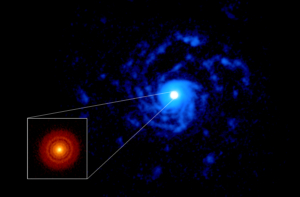
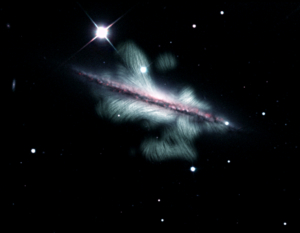
Magnetic Field of a Spiral Galaxy
An image from the VLA dramatically reveals the huge extent of the magnetic field of a spiral galaxy seen edge-on from Earth.
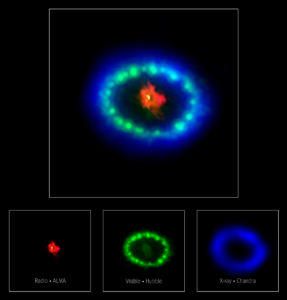
Multiwavelength image of Supernova 1987A
This colorful, multiwavelength image of the intricate remains of Supernova 1987A is produced with data from three different observatories. The red color shows dust and cold gas in the center of the supernova remnant, taken at radio wavelengths with ALMA. The green and blue hues reveal where the expanding shock wave from the exploded star is colliding with a ring of material around the supernova. The green represents the glow of visible light, captured by NASA’s Hubble Space Telescope. The blue color reveals the hottest gas and is based on data from NASA’s Chandra X-ray Observatory. The ring was initially made to glow by the flash of light from the original explosion. Over subsequent years the ring material has brightened considerably as the explosion’s shock wave slams into it.

“The blob” in Supernova 1987A
Extremely high-resolution ALMA images revealed a hot “blob” in the dusty core of Supernova 1987A (inset), which could be the location of the missing neutron star. The red color shows dust and cold gas in the center of the supernova remnant, taken at radio wavelengths with ALMA. The green and blue hues reveal where the expanding shock wave from the exploded star is colliding with a ring of material around the supernova. The green represents the glow of visible light, captured by NASA’s Hubble Space Telescope. The blue color reveals the hottest gas and is based on data from NASA’s Chandra X-ray Observatory. The ring was initially made to glow by the flash of light from the original explosion. Over subsequent years the ring material has brightened considerably as the explosion’s shock wave slams into it.
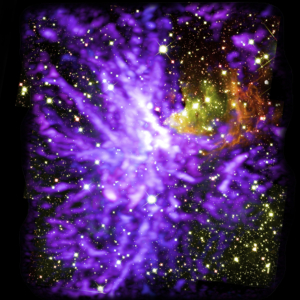
ALMA Mosaic Star Cluster
Image of star cluster G286.21+0.17, caught in the act of formation. This is a multiwavelength mosaic of more than 750 ALMA radio images, and 9 Hubble infrared images. ALMA shows molecular clouds (purple) and Hubble shows stars and glowing dust (yellow and red).
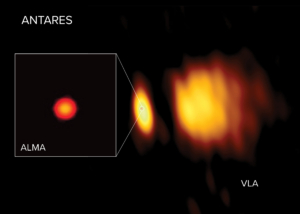
Radio images of Antares
Radio images of Antares with ALMA and the VLA. ALMA observed Antares close to its surface in shorter wavelengths, and the longer wavelengths observed by the VLA revealed the star’s atmosphere further out. In the VLA image a huge wind is visible on the right, ejected from Antares and lit up by its smaller but hotter companion star Antares B.





